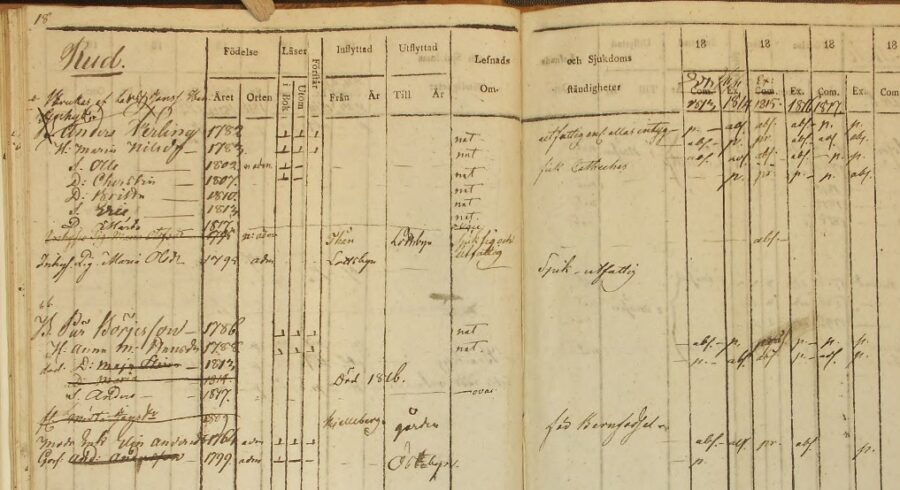Delving into the captivating realm of family history research allows us to uncover the stories and legacies of our ancestors. One invaluable resource that has stood the test of time is using census records to trace our ancestors. These meticulously compiled records provide a window into the past, offering a wealth of information about our relatives and the communities they inhabited. By harnessing the power of census records, we can piece together the puzzle of our family history and gain a deeper understanding of our roots.
In this article, we embark on a journey of exploration, discovering the myriad ways in which census records can help us trace our family lineage. We will delve into the intricacies of these historical documents, guiding you through the process of navigating, interpreting, and extracting valuable information from census records. From deciphering names and ages to unraveling occupation details and migration patterns, each section will shed light on a different aspect of utilizing census records effectively.
Whether you are a novice genealogist or an experienced family history enthusiast, this guide aims to equip you with the tools and knowledge necessary to make the most of census records in your quest to unveil your family’s past. So, join us as we step back in time, immersing ourselves in the rich tapestry of census records and unearthing the stories that connect us to our ancestors.
NAVIGATING CENSUS RECORDS: UNDERSTANDING FORMATS AND AVAILABILITY
Navigating through the vast ocean of census records may seem daunting at first, but with a few key insights, you can confidently navigate these valuable resources. Understanding the formats and availability of census records will empower you to effectively locate and access the information you seek.
Census records have been meticulously collected and preserved by governmental agencies for centuries. They vary in format, depending on the time period and region, but the two most common types are the decennial census and the population schedule. The decennial census occurs every ten years and aims to count and gather data on the entire population. On the other hand, population schedules are detailed questionnaires filled out by individuals within each household during a specific census year.
To access census records, you can turn to various sources. National archives, libraries, genealogical societies, and online databases are all potential avenues for uncovering these valuable documents. Governmental agencies often provide digital copies or microfilm versions of census records, making them accessible from the comfort of your own home. Online platforms dedicated to genealogical research, such as Ancestry.com or FamilySearch.org, offer extensive databases that allow you to search and explore census records from different time periods and regions.
When delving into census records, keep in mind that availability may vary depending on the country and the year of the census. Some records may have been lost, damaged, or destroyed due to various factors, such as wars or natural disasters. Additionally, privacy laws can impact the accessibility of more recent census records.
To effectively navigate census records, it is essential to have a clear understanding of the time period and location you are researching. Familiarize yourself with the census year and the questions asked during that specific census. Pay attention to any changes in formatting or terminology that may occur across different years, as these variations can impact your search and interpretation of the data.
By familiarizing yourself with the formats and availability of census records, you are equipped with the knowledge necessary to embark on a fruitful exploration of your family history.
EXTRACTING KEY INFORMATION: ANALYZING NAMES, AGES, AND RELATIONSHIPS
Within the vast treasure trove of census records, lies a wealth of information waiting to be discovered. As you embark on your journey to trace your family history, one of the primary tasks is to extract key information from the census records, deciphering names, ages, and relationships that weave together the story of your ancestors.
Names are the fundamental building blocks of genealogical research. Census records provide valuable insights into the names of individuals and their family members, helping you establish connections and trace lineages. When analyzing names, be aware of potential variations, misspellings, or transcription errors that can occur due to human error or different interpretations of handwriting. Keep an open mind and explore different possible spellings or alternative names that your ancestors might have used.
Ages listed in census records can provide significant clues about birth years, aiding in further research and establishing a timeline of your ancestors’ lives. However, ages can sometimes be approximate or inaccurate, especially if individuals were unsure of their birth dates or if enumerators estimated ages based on appearance. Use ages as a guide but cross-reference with other sources for more accurate information.
Another crucial aspect of census records is unravelling the relationships between individuals within a household. By carefully examining the household composition, you can identify immediate family members, extended relatives, or even boarders and servants who shared the same living space. Relationships are often explicitly mentioned, indicating whether an individual is a head of the household, a spouse, a child, or a sibling. These relationship designations provide vital clues for building your family tree and understanding the dynamics within your ancestral families.
When analyzing names, ages, and relationships, it’s important to approach the data critically. Consider the context in which the information was recorded and any potential biases or inaccuracies that may arise. Collaborate with other researchers, share findings, and cross-reference information to ensure accuracy and completeness in your family history research.
As you extract key information from census records, you begin to piece together the puzzle of your family’s past. Names, ages, and relationships create a framework that connects generations and provides a deeper understanding of your ancestral heritage.
UNCOVERING OCCUPATIONS: DISCOVERING YOUR ANCESTORS’ WORK AND TRADES
Beyond names and relationships, census records offer a fascinating glimpse into the occupations and trades pursued by our ancestors. These records provide valuable insights into how our forebears earned a living, the skills they possessed, and the industries they contributed to. Exploring the occupation details within census records can add depth and richness to your family history research.
Occupational information recorded in census records varies in detail and accuracy across different time periods. Early census records might provide only a basic description of the occupation, such as “farmer” or “laborer.” However, as census practices evolved, more specific occupational titles and details were captured, offering a clearer understanding of your ancestors’ work.
When deciphering occupation details, it’s important to consider that job titles may have changed over time or might be specific to a particular region or industry. Some occupations may no longer exist or have transformed significantly, reflecting shifts in societal and economic structures. Don’t be surprised if you come across job titles that are unfamiliar or require further research to fully comprehend their nature.
Beyond the job titles themselves, the occupation information can provide valuable insights into the social and economic standing of your ancestors. Certain occupations might indicate a level of specialization, education, or social status within the community. By studying the occupations of multiple family members within a household or across generations, you can uncover patterns, trends, and family traditions related to specific trades or industries.
Exploring your ancestors’ occupations can also open doors to understanding their daily lives, the challenges they faced, and the communities they were a part of. Consider the geographical context of your ancestors’ occupations, as certain areas might have been known for specific industries or trades. Research local historical records, directories, and industry-specific resources to gain a deeper understanding of the work environment and opportunities available during your ancestors’ time.
As you uncover the occupations of your ancestors, take note of any interesting or unique findings. Engage with local historical societies or online genealogy communities to learn more about the intricacies of specific trades or industries. By immersing yourself in the world of their work, you can gain a greater appreciation for the skills, determination, and resilience of your ancestors.
TRACING MIGRATION PATTERNS: UNVEILING YOUR ANCESTORS’ JOURNEYS
Migration is a fundamental part of human history, and census records can be valuable tools for tracing the geographic movements of your ancestors. Understanding their migration patterns can provide significant insights into their lives, motivations, and the historical context in which they lived. By examining where your ancestors lived and moved over time, you can unveil fascinating details about their journeys and discover new branches of your family tree.
Census records often capture the location of individuals and families at the time of each enumeration. This information allows you to track their movements from one census year to another. Pay close attention to the addresses, townships, counties, or states listed in the records. These details can serve as starting points for further exploration and research.
Start by creating a timeline of your ancestors’ residences based on the census records available. Note any changes in location, as well as the intervals between moves. Look for patterns that might indicate specific reasons for relocation, such as economic opportunities, family ties, or significant historical events.
As you trace migration patterns, consider the broader historical context that might have influenced your ancestors’ decisions to move. Changes in industries, land availability, political climates, and even natural disasters could have played a role in shaping their journeys. Research local histories, maps, and newspapers to gain a deeper understanding of the factors that influenced migration during the time period in question.
Exploring migration patterns can also lead to the discovery of new branches of your family tree. As your ancestors moved, they likely established connections and formed relationships in their new communities. By identifying these connections, you can expand your research to include collateral relatives, neighbors, and others who may have played a significant role in your family’s history.
It’s important to keep in mind that migration patterns can vary greatly from one family to another. Some families may have migrated frequently, seeking new opportunities or escaping adverse conditions. Others might have remained in the same area for generations, maintaining strong ties to a particular region. Understanding these migration patterns can help paint a more complete picture of your ancestors’ lives.
In addition to census records, explore other resources such as passenger lists, naturalization records, land records, and city directories to gather additional evidence of your ancestors’ movements. These documents can provide complementary information and help fill in gaps in your research.
Tracing migration patterns is a captivating aspect of genealogy research that allows you to follow in the footsteps of your ancestors. By mapping their journeys, you can gain a deeper appreciation for the challenges they faced, the opportunities they pursued, and the legacy they left behind.
BEYOND THE CENSUS: SUPPLEMENTING RESEARCH WITH ADDITIONAL RECORDS
While census records are invaluable for tracing your family history, they are just one piece of the puzzle. To paint a more comprehensive picture of your ancestors’ lives, it’s essential to supplement your research with additional records and sources. These supplementary records can offer unique insights, fill in gaps, and provide a deeper understanding of your family’s story. Here are some key records to consider exploring:
- Vital Records: Birth, marriage, and death records are essential for tracing lineages and confirming relationships. These records often contain valuable details such as names, dates, and places of vital events. They can help you establish connections between generations and uncover vital information about your ancestors.
- Immigration and Naturalization Records: If your ancestors immigrated to a new country, immigration and naturalization records can be treasure troves of information. Passenger lists, ship manifests, and naturalization documents can provide details about their arrival, origins, and sometimes even their physical descriptions. These records can open up new avenues for research and help you understand the journey your ancestors took to establish themselves in a new land.
- Military Records: Military records can offer insights into your ancestors’ military service, including enlistment dates, units, and even personal descriptions. These records may also shed light on their experiences during conflicts and provide glimpses into their lives outside of military service. Explore military pension records, draft registration cards, and service records to uncover the military history of your ancestors.
- Land and Property Records: Land and property records can reveal important aspects of your ancestors’ lives, including where they lived, their economic status, and their involvement in local communities. Deeds, land grants, and property tax records can help you track the ownership and transfer of land over time, providing a sense of stability and place in your family’s history.
- Church and Cemetery Records: Religious institutions and cemeteries often kept meticulous records of baptisms, marriages, burials, and other important events in their congregants’ lives. These records can offer valuable genealogical information, including names, dates, and familial relationships. Church records may also provide insights into your ancestors’ religious beliefs, affiliations, and community involvement.
- City Directories: City directories are invaluable for tracking your ancestors’ residences, occupations, and even their social networks. These directories, often published annually, list individuals and businesses in a specific area, providing a snapshot of your ancestors’ lives during a particular time period. They can help you follow your ancestors’ movements between censuses and uncover new details about their daily lives.
- Newspapers: Local newspapers are a rich source of historical information, including birth and marriage announcements, obituaries, court records, business advertisements, and news articles. They can provide fascinating glimpses into the lives, achievements, and even scandals of your ancestors. Newspapers can be accessed through local libraries, historical societies, and online archives.
- DNA Testing: While not a traditional record, DNA testing can offer powerful insights into your genetic ancestry and connect you with distant relatives. DNA matches can provide valuable leads for expanding your family tree, confirming relationships, and discovering branches of your family you may not have known existed. Consider taking a DNA test and exploring the tools and resources provided by the testing company to maximize your research potential.
By venturing beyond census records and exploring these additional sources, you can uncover a wealth of information about your ancestors’ lives, experiences, and connections. Each record adds a new layer to your family’s story, helping you piece together the intricate puzzle of your heritage. As you delve into these records, don’t forget to record your findings, analyze the information critically, and continue to build upon your research.





